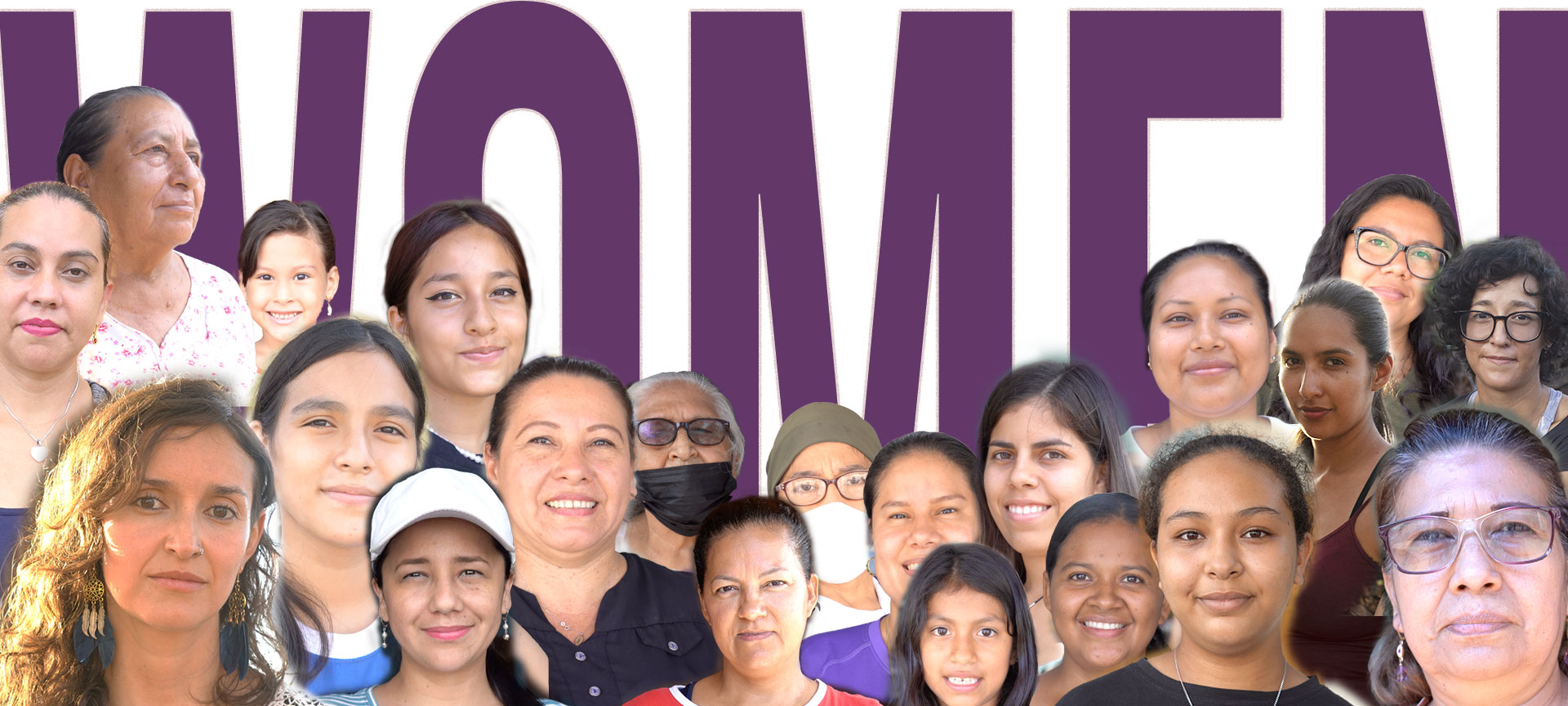Creating Space
In a place where more attention is paid to tourism and tortoises, Galápagueñans are steering a cultural evolution.
Creating Space
In a place where more attention is paid to tourism and tortoises, Galápagueñans are steering a cultural evolution.
REPORTER
Chris Kammerer
PHOTO
Abigail Pittman
VIDEO
Alex Berenfeld
Renata Schmidt
INTERACTIVE
Susie Webb
“Ecuadorians… sleep peacefully surrounded by roaring volcanoes, they live
poor among incomparable riches and they become happy listening to sad music.”
—Alexander von Humboldt, German explorer, circa 1800s
Rocio Bermeo was 19 when she got pregnant with her first child. It was 1977. She couldn’t find anyone in Quito to assist with an at-home delivery, so she and the baby’s father flew up to San Francisco, California, to live among the hippies and learn how to give birth.
Two months later, Bermeo and her son, Nicolas, flew back to Quito without his dad. “The father didn’t want to be a father,” she says.
Eight years later, she met Hugo Idrovo, an accomplished Ecuadorian songwriter, journalist and historian. The two of them married and had three more sons and a daughter. The daughter died in a devastating accident when she was 18 months old.
“When you understand life, you understand death,” says Bermeo. Her eyes turn red, and she makes a gesture of receiving: “So you just go, ‘Okay. Thank you.’”
The family started vacationing in the Galápagos in 1995; the slow-paced, back-to-nature atmosphere appealed to their Bohemian spirit. In those days, the plane to and from the mainland only flew every two weeks. One day in 1998, the plane was due to leave, but the family decided to stay another two weeks. When those weeks passed, they skipped the plane again. And again.
Eventually Bermeo and Idrovo sat the kids down and asked, “Do you want to go back to Quito, or would you rather stay here for good?” The answer was unanimous. The family settled in San Cristóbal.
REPORTER Chris Kammerer
PHOTO Abigail Pittman
VIDEO Alex Berenfield| Renata Schmidt
INTERACTIVE Susie Webb
“Ecuadorians… sleep peacefully
surrounded by roaring volcanoes,
they live poor among incomparable riches
and they become happy listening to sad music.”
—Alexander von Humboldt, German explorer, circa 1800s
Rocio Bermeo was 19 when she got pregnant with her first child. It was 1977. She couldn’t find anyone in Quito to assist with an at-home delivery, so she and the baby’s father flew up to San Francisco, California, to live among the hippies and learn how to give birth.
Two months later, Bermeo and her son, Nicolas, flew back to Quito without his dad. “The father didn’t want to be a father,” she says.
Eight years later, she met Hugo Idrovo, an accomplished Ecuadorian songwriter, journalist and historian. The two of them married and had three more sons and a daughter. The daughter died in a devastating accident when she was 18 months old.
“When you understand life, you understand death,” says Bermeo. Her eyes turn red, and she makes a gesture of receiving: “So you just go, ‘Okay. Thank you.’”
The family started vacationing in the Galápagos in 1995; the slow-paced, back-to-nature atmosphere appealed to their Bohemian spirit. In those days, the plane to and from the mainland only flew every two weeks. One day in 1998, the plane was due to leave, but the family decided to stay another two weeks. When those weeks passed, they skipped the plane again. And again.
Eventually Bermeo and Idrovo sat the kids down and asked, “Do you want to go back to Quito, or would you rather stay here for good?” The answer was unanimous. The family settled in San Cristóbal.
“Galapagos is a paradise. That is, it is a magical place where, as in every society, we have problems.
San Cristóbal is the second-most populated island in the Galápagos. The first confirmed human arrival was in 1535. For the next three centuries, the islands served as a hideout and trading post for pirates and whalers who exploited the giant tortoises, whales and fur seals and introduced non-native animals to the environment.
After Ecuador claimed possession of the islands in 1832, the first governor secured the pardon of 80 prisoners to help establish a colony on Floreana called “The Refuge of Peace.” It failed within five years due to lack of fresh water—around the time Charles Darwin arrived on the HMS Beagle. For the rest of the century, colonizers built a series of short-lived plantations that relied on slave labor, until the prisoners revolted and executed their overlords.
Around 1910, settlers from the mainland of Ecuador, Germany and Sweden began farming in the highlands of San Cristóbal and Santa Cruz, sowing the seeds of the towns that exist today.
Most people outside the region think of the Galápagos as a nature preserve devoted to biological study and conservation, a tropical Antarctica. While the natural splendor draws people from all over the planet, the locals live in charming, semi-typical tourist towns—with restaurants, bars, hotels and shops that offer turtle merch, surf equipment and scuba tours. They also face much of the rest of the world’s issues—sexism, xenophobia, political conflict—surrounded by water that is limitlessly blue.
Bermeo says the people of San Cristóbal did not initially accept her. For many years, they called her “la gringa,” thinking she and her family were rich because of her white skin and blue eyes. Contrary to that perception, she and Idrovo were still renting until recently.
Two years ago, Bermeo, now 64, designed an open-air bungalow and bought a small lot in the higher part of town where she could build it. “Before I came [to the Galápagos], I thought I was going to find houses like this one,” she says, lying in her hammock on the second floor. Her home is a fantastic departure from the cinder-block-and-cement buildings everywhere else on the island: the sugar cane walls don’t meet the roof; floors were sawn from matazarno, an endemic wood; the outdoor shower hides behind a sugar cane fence; a breeze wanders through the living room, granting blessed reprieve from the equatorial heat.
This is the first house she’s ever owned. “It cost a lot of years,” she says.
Bermeo moved in at the beginning of March this year, without Hugo. “He always did what he wanted, and I always supported him.” After 30 years of marriage, she told him, “No more. Now it’s my time.”
They divorced, and Hugo moved back to the mainland. “I love him very much,” she says, “but it’s time for each of us to do what we want.”
A Mother’s Love and A Seamstress’ Needle
The women of San Cristóbal come to Ely’s Confecciones for custom-made dresses and tailored items. The namesake designer, Maria Elizabeth Alava-Mendoza, or “Ely,” works from a metal shipping container that sits right next to her family’s home.
Alava’s three children guide her work and day-to-day life. She once studied to be a teacher, but found that the profession caused her to be away from them too often. “It’s for them that I live,” she said.
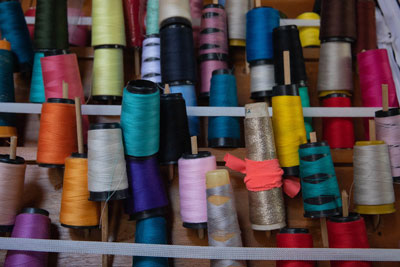

Finding Their Voices
A few blocks from Rocio Bermeo’s dream house is the Casa de la Música. The mural on the front of the building depicts women sewing a golden quilt on the shore of a lavender ocean. Three of the women’s heads are astronaut helmets that contain spiraling galaxies.
Isabel Rocha arrives a little before 6 p.m. to unlock the gate. At the beginning of March, she started a singing group for women called Trenzando Voces (Braiding Voices).
Here in the large bare room, Rocha sets out rubber mats with puzzle-piece sides. “In San Cristóbal,” she says, “there are no spaces where women can recover themselves, find themselves and that are exclusive to them.”
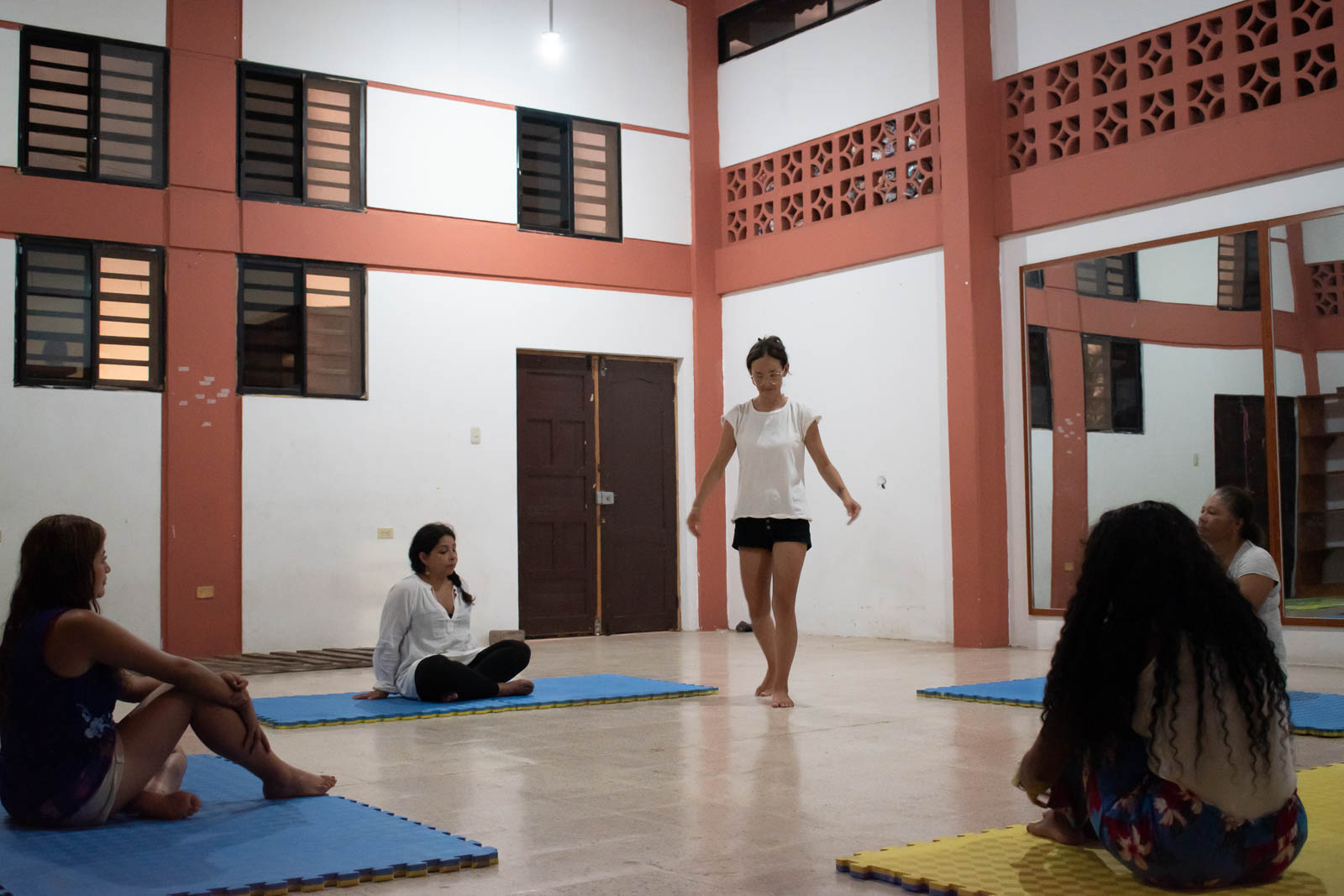
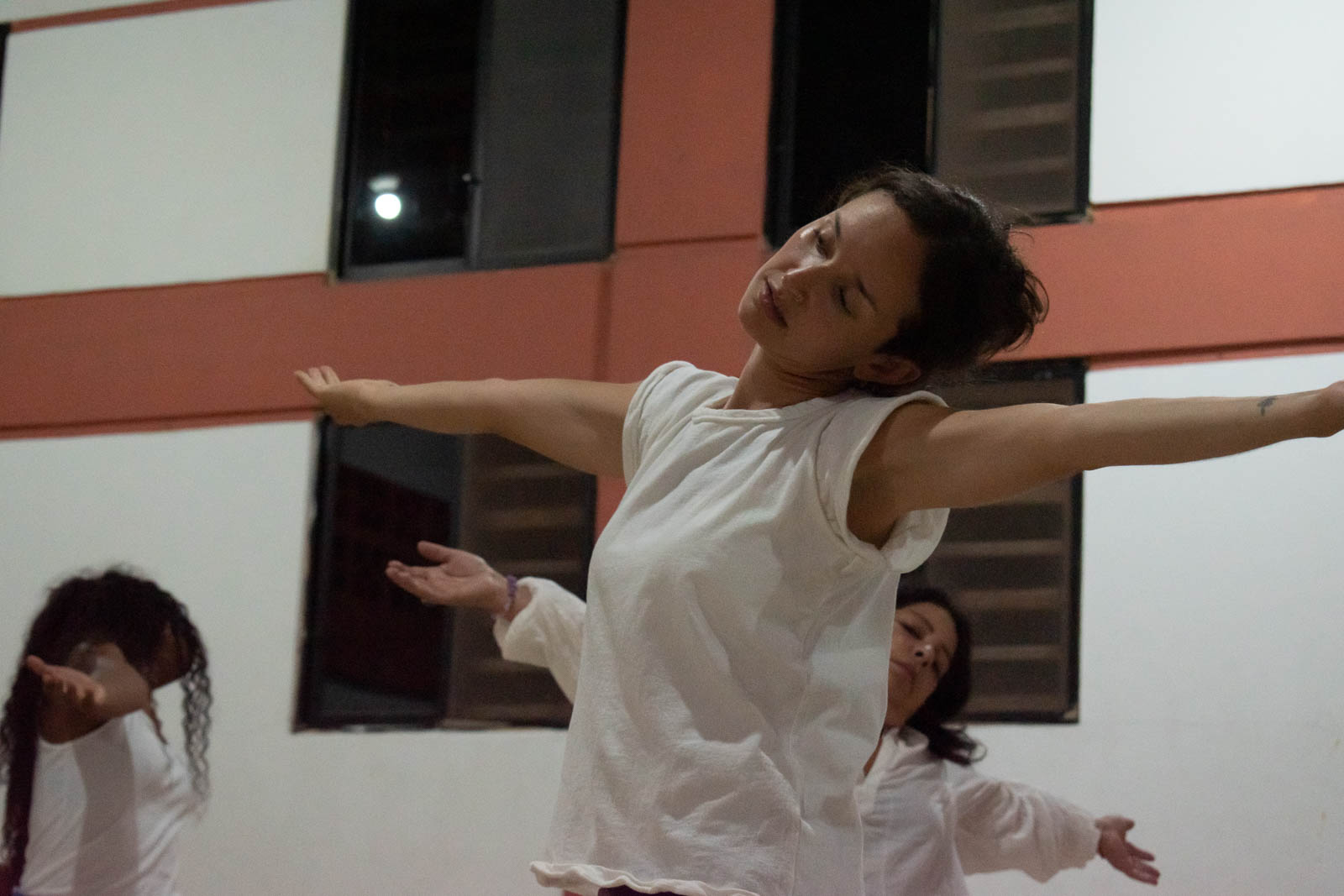
Isabel Rocha leads a voice class for her singing group Trenzando Voces (Braiding Voices) on March 17, 2022.
For two hours, she guides four women through the fundamentals of breathing and posture. Her lesson mixes yoga, Qigong, singing and acting exercises. It is only the group’s third meeting. They hope to develop a catalog of songs for performances, but for now, they’re starting with the basics.
“It allows women to regain their voice, to regain their sense of value,” she says. “Singing is a tool of healing, of self-knowledge that fills us with life. And I think women deserve that, to fill ourselves with life again.”
Trenzando Voces is one of dozens of groups across the Galápagos that are part of Tejido Violeta (“Purple Fabric”), a collective devoted to empowering women and raising awareness about gender violence. Other groups in Tejido Violeta include feminist groups such as MAGMA and the Galápagos Arabesque Dance Academy, a dance school for children and young people led by Johanna Ricaurte.
“Well, it’s really my dream as part of Tejido Violeta, as part of people who work with girls, with boys, with young people here in the community — in other words, it is to be able to justly eradicate violence.”
Viviana Vizuete Coronel, a spokesperson for Tejido Violeta, says that organizing around these issues can be polarizing. Even within the collective, not all groups are in agreement about where they stand on certain issues, such as abortion rights, or whether to call the group “feminist.” Still, they are united by a shared urgency to raise awareness about violence against women.
“There are women who simply don’t recognize violence as something negative, but as something that only happens,” says Vizuete. “The biggest goal is to make violence visible.”
A Fight For Women in the Galápagos
In the Galapágos, cases of psychological violence, rape, sexual harassment and abuse are prevalent.
Groups of women on the islands have dedicated themselves to combatting this violence against women.
In 2020, the femicide of Jennifer Haz Beltrán shocked the people of the Galápagos.
A femicide is the intentional killing of women because of their gender. Jennifer was 31-years-old and was murdered on Santa Cruz by an ex-partner. After her murder, women’s groups across the Galápagos held sit-ins and rallies calling for an end of gender-based violence and demanding collective action.
Across the islands near 30 women’s rights organizations emerged.
Tiejdo Violeta — led by a network of women on San Cristóbal — is one of the most prominent of these women’s rights groups.
Together these women are working to combat the normalization of violence against women through…
Song

Art
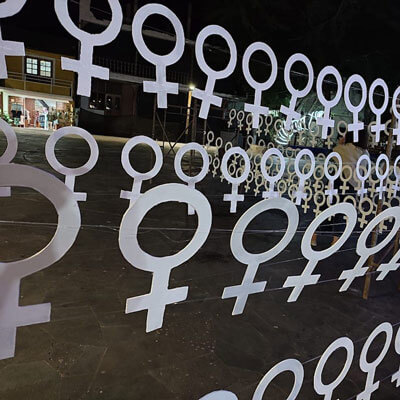
Dance

Workshops
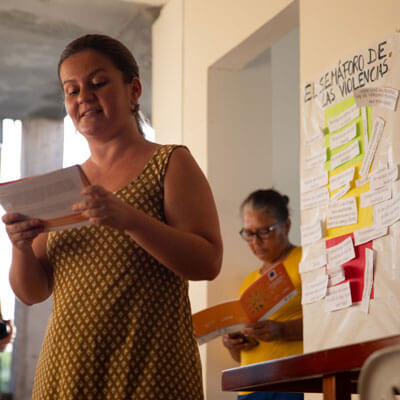
In an Instagram post from December 7, 2021, Tejido Violeta wrote that from January 1 to November 15, Ecuador had “172 registered cases of women and girls violently murdered for reasons of gender (8 transfemicides and 67 deaths from organized crime).” In Ecuador, as in much of Latin America and Europe, these are officially documented as “femicides.”
According to the World Health Organization, femicide is defined as the “intentional murder of women because they are women,” and usually involves domestic abuse, threats, intimidation and sexual violence. An ongoing study by WHO says that “35% of all murders of women globally are reported to be committed by an intimate partner. In comparison,… only about 5% of all murders of men are committed by an intimate partner.” The United States does not currently keep a record, nor have a legal definition, for femicides.

“The loss of a Galápagos sister awakened anger and the need for justice.”
Viviana Vizuete Coronel, Tejido Violeta.
Tejido Violeta cited the Aldea Foundation, a nonprofit based in Quito, which estimates that between 2014—when femicide became defined by Ecuadorian law—and 2021, there were 1,047 recorded femicides, leaving 1,281 children and adolescents orphaned as a result.
Many people are resistant to talking about these issues, according to Vizuete. She says that most of the groups in Tejido Violeta have only about 10 members each. That means that in the Galápagos, a couple hundred people are raising awareness about gender violence among a population of over 30,000.
“This is a long, long, very tiring and very difficult process, but we want to do it,” Vizuete says. “In the end, collective force is what changes public policies, what changes social dynamics and what changes culture. Remember that culture doesn’t make us; we make culture. We are societies that are constantly moving.”
Reported Complaints of Gender-Based Violence in the Galápagos Islands
Leaving to Come Back
Jenny Quijozaca is a member of Trenzando Voces and the co-founder and head brewer of Endémica Galápagos, the first craft brewery on San Cristóbal.
Quijozaca was born and raised on the island. She studied marine ecology at the Universidad San Francisco de Quito in the mainland of Ecuador, where she met her husband, Dani, who is from Galicia—a region of Spain famous for its brewing culture. After graduating in 2013, the two lived there for a while and eventually decided to start a brewery back in Jenny’s hometown. Endémica opened in 2016.
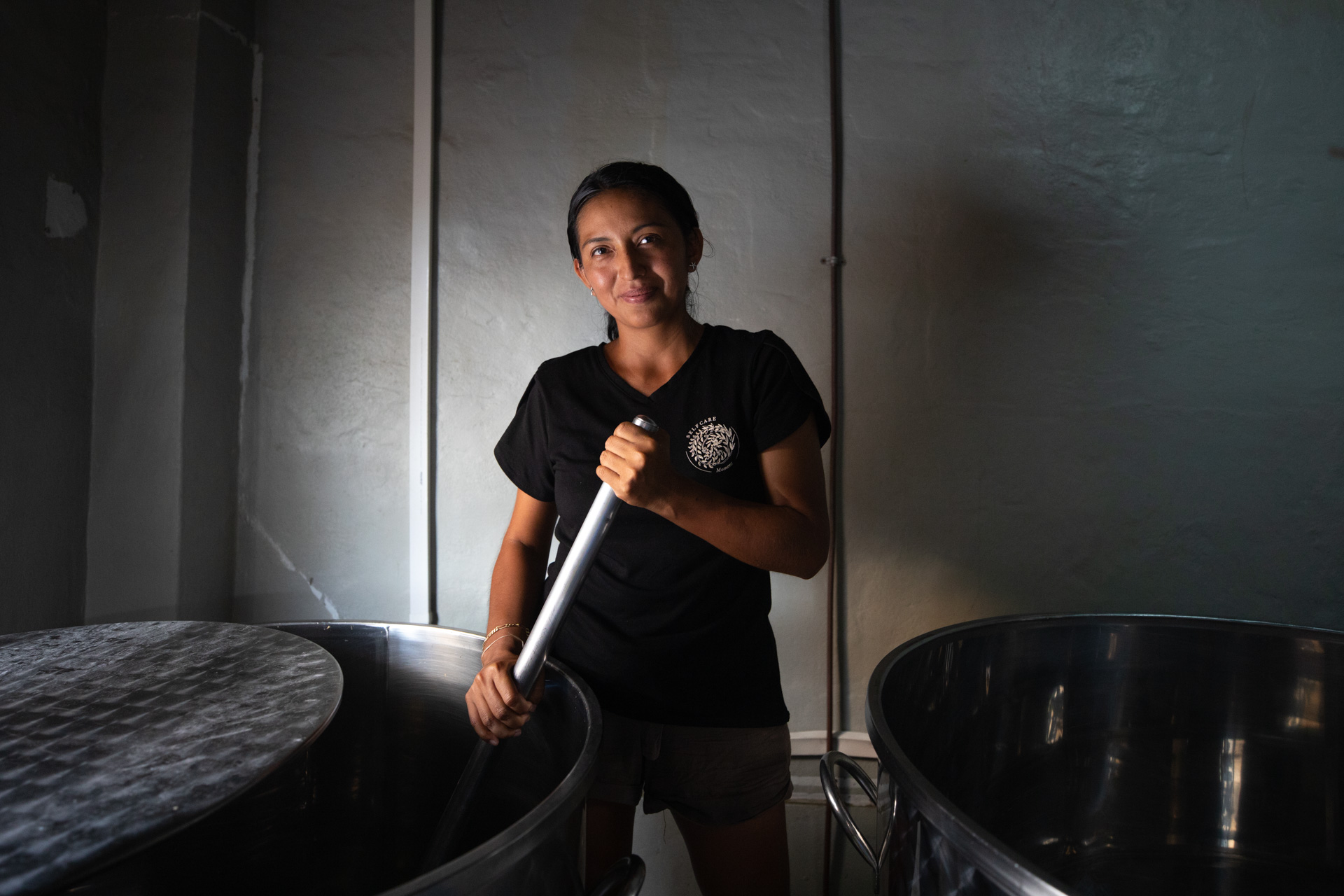
Jenny Quijozaca runs Endémica Brewery in San Cristóbal.
The tour starts just like it does at any microbrewery: first, we visit the ingredients. Bags of malts and hops from Germany and Argentina are stacked in what used to be a bedroom. Quijozaca says they want to operate more sustainably by growing their own hops on San Cristóbal, but the authorities already give them a hard enough time for importing the aromatic green pellets in bulk.
Hops, though completely legal, are a flowering vine in the same family as cannabis. Everything that comes to the Galápagos is searched thoroughly, partly to protect the environment from invasive plants, but also because there is a problem with cartels smuggling drugs through the islands. Officials are reluctant to grant permission to a hop-growing operation, fearing it could be a cover for a marijuana farm.
“We are a very conservative population,” Quijozaca says. “You have to be very cautious when you are speaking, not to propose some big change.”
We move on to the 500 mL brew tanks, which have wheels so they can be rolled into a cooler while the beer ferments—an innovation I’ve never seen before. Quijozaca explains that if they weren’t in the cooler, the climate would cause the beer to ferment at too high of a temperature.
At the end of the tour, Quijozaca turns the interview on me, asking my motivations for reporting here. “How does this contribute to the community?” she asks.
“Remember that culture doesn’t make us; we make culture.”
Earlier that day, her husband impressed upon me how meager the news coverage is on the islands. The locals rely on one decent radio station, and gossip.
I tell her about our project, how I’m there to write about culture.
“Now that you’ve done the interviews, what do you think of the culture of the Galápagos?” she asks.
Cue the nervous American.
“It reminds me of Montana,” I say. “It’s a place where people try to escape the things that they don’t like about Ecuador, or wherever they come from, and they try to build a new life here… I think people are trying to really raise awareness and consciousness about human impacts and being better to each other, being better to the planet, and I’m really inspired by it. I think it’s really beautiful over here.”
“And how, in one word, would you describe the culture of the Galápagos?”
Several dumb words come to mind. Finally, I say, “Caring?”
She nods, unimpressed.
I ask what word she would use.
“División.”
She says she wishes she could describe the culture as “united,” but that with so many competing interests, the Galápagos today feels very divided.
I concede that having only been in the Galápagos for less than a week, it’s easy for me to focus on everything beautiful and inspiring here.
Then she asks, “Where are you from?”
“North Carolina.”
“How long have you lived there?”
“Four years.”
“¿Y qué es la cultura allí, para ti? En una palabra.”
I laugh. “Oh. Yeah. Division.”
New Rhythms
There are 11 drum sets on San Cristóbal. Gonzalo Fernandez owns three of them. In 2021, he started the Galápagos Drum Academy. Initially intended only to be a month-long camp for kids who were on holiday break, the academy is still going strong one year later.
Tuesdays and Thursdays, Fernandez holds three one-hour lessons, with three students at a time, coaching them through the foundations of rhythm in a style he calls “percussion vivencial“ (experiential percussion). He developed the method years ago with a jazz drummer back in the mainland.
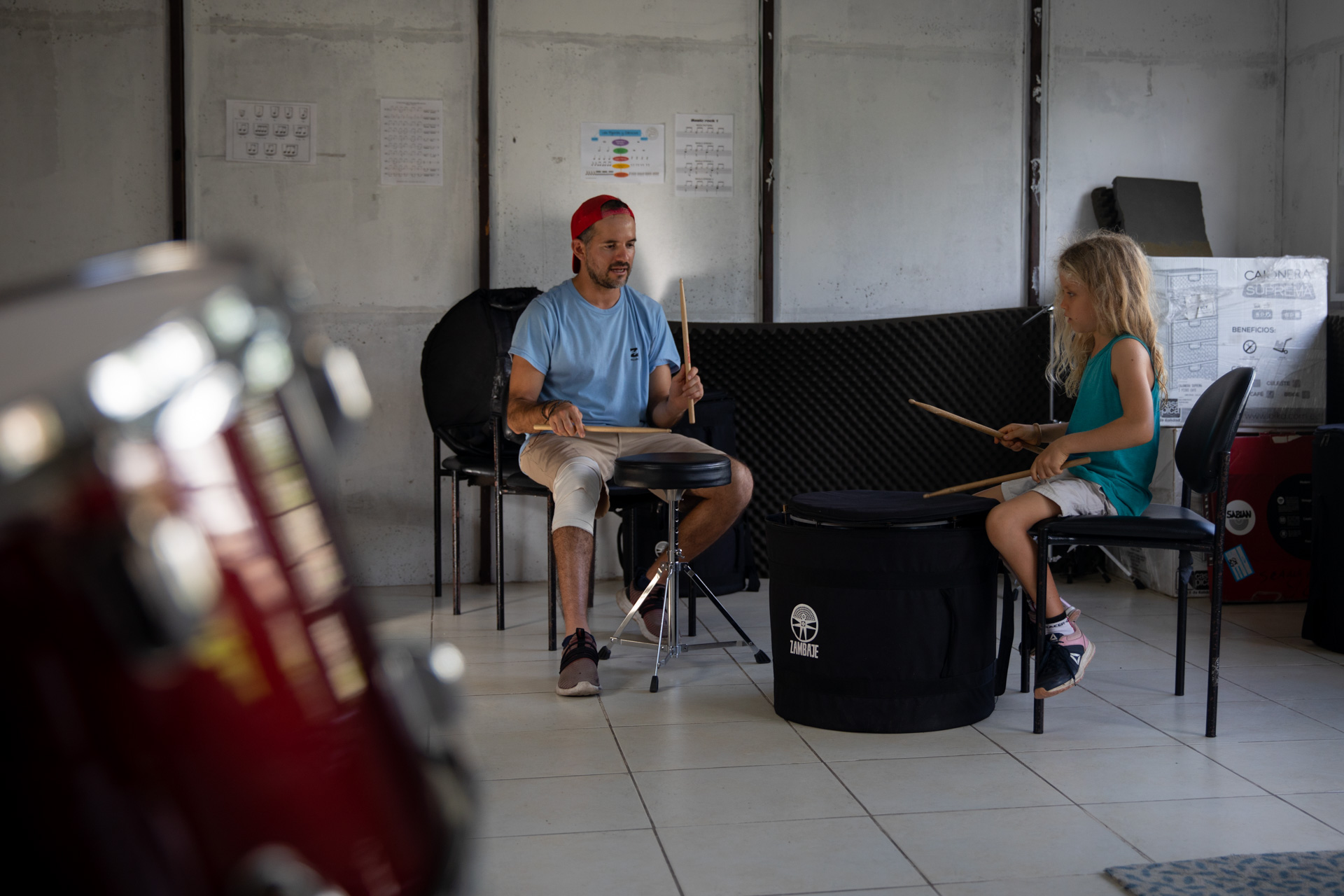
Gonzalo Fernandez teaches a lesson at his drum academy in San Cristóbal.
During the first lesson, students don’t start with the drum kit, or any drums at all. Instead, Fernandez asks the students to talk about what noises and rhythms occur in nature: the sound of volcanoes, the rain, a person’s walk or everybody’s first rhythm—their mother’s heartbeat. Then he grabs some dry leaves or other found objects for the students to make music with.
After that, Fernandez asks the students how they are today, but tells them not to answer in words. “I don’t want them to say ‘I’m okay, or I’m bad, I’m good.’ I ask them to breathe three times really deep, close their eyes, and then play on their body.”
Then technical discipline arrives in the form of drums and sticks.
Fernandez and his wife had their first son a few months earlier. When I ask what he hopes for his son here on the islands, he says that he and his wife will only raise him in San Cristóbal for the first 8 to 10 years. After that, the family will most likely move elsewhere, Spain perhaps, to provide him a better education.
“In Galápagos, we live in two sides,” says Fernandez. “One is the beautiful”—the national park, living close to nature, sunsets on the beach, swimming and surfing. “But the other side is the raw, it’s the hard things.”
The first hard thing he highlights is that many people are overly fixated on making money. He worries about “cultural abandonment,” a tendency for people to neglect the arts. He also says Galápagueñans have a stubborn sense of independence that leads to xenophobia. While the locals embrace the tourists who support most of their salaries, they resist welcoming new residents from the outside, even mainland Ecuadorians.
“We are in a natural laboratory. So we need also to evolve the minds of the people here,” says Fernandez. “This is where art goes.”
“Only art and culture mobilizes the spirit of human beings.”
Isabel Rocha of Trenzando Voces also feels that arts and culture are often “abandoned.”
“A lot of attention has been paid to the environment, to conservation, to the ecosystem, forgetting that society is part of this ecosystem,” Rocha says. “No support is given to cultural projects, and I think it is time to start demanding that the authorities pay attention, because only a people who have art and culture will be able to have the conviction to demand what they need, what is good for them. Only art and culture mobilizes the spirit of human beings.”
Dulce Sentimientos
Fernandez used to play in a band called “Arkabuz” with Rocio Bermeo’s sons, Nicolas Bermeo and Federico “Fede” Idrovo. The two brothers still play in that band, but Fernandez has moved on, though he lives right around the corner from Bermeo’s sugar cane house.
On a Saturday evening in March, a week after helping his mom move in, Fede sits beside the lighthouse at Playa Mann with his guitar and plays a new song he wrote called “Dulce Sentimientos” (“Sweet Feelings”).
“We used to confuse love with possession,” Fede says, explaining why he wrote the song. “If you really love somebody, you need to let that person to just be. If that person is still choosing you, every day, that’s perfect.”
The song is an upbeat fusion of blues rock and reggae, with fast-spoken verses interspersed between lilting choruses. The sunset lights up the clouds above a hundred anchored boats. To close, Fede raps, “By the sea, we learned to love and hate each other. / And tonight, while we are separated / we would just like to be together.”
The mosquitoes are so relentless, he slaps himself while he plays.

